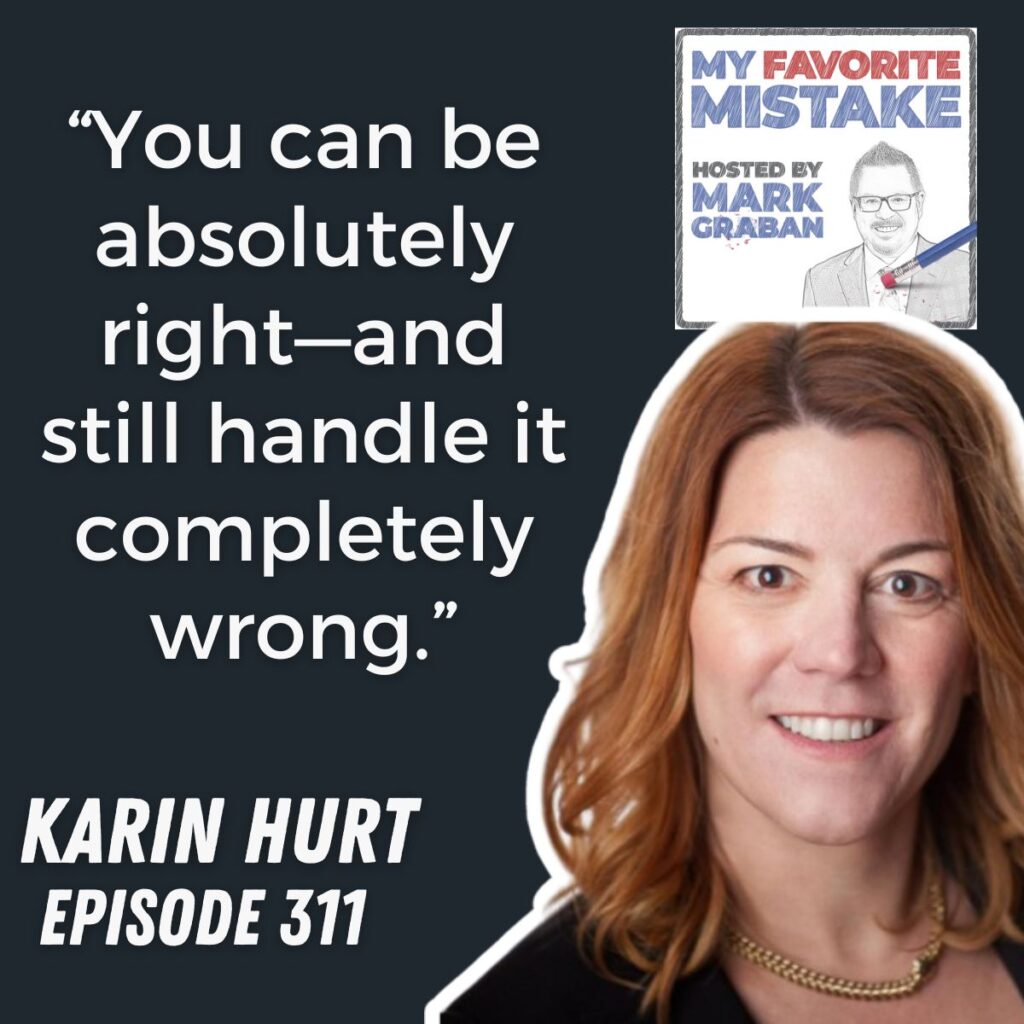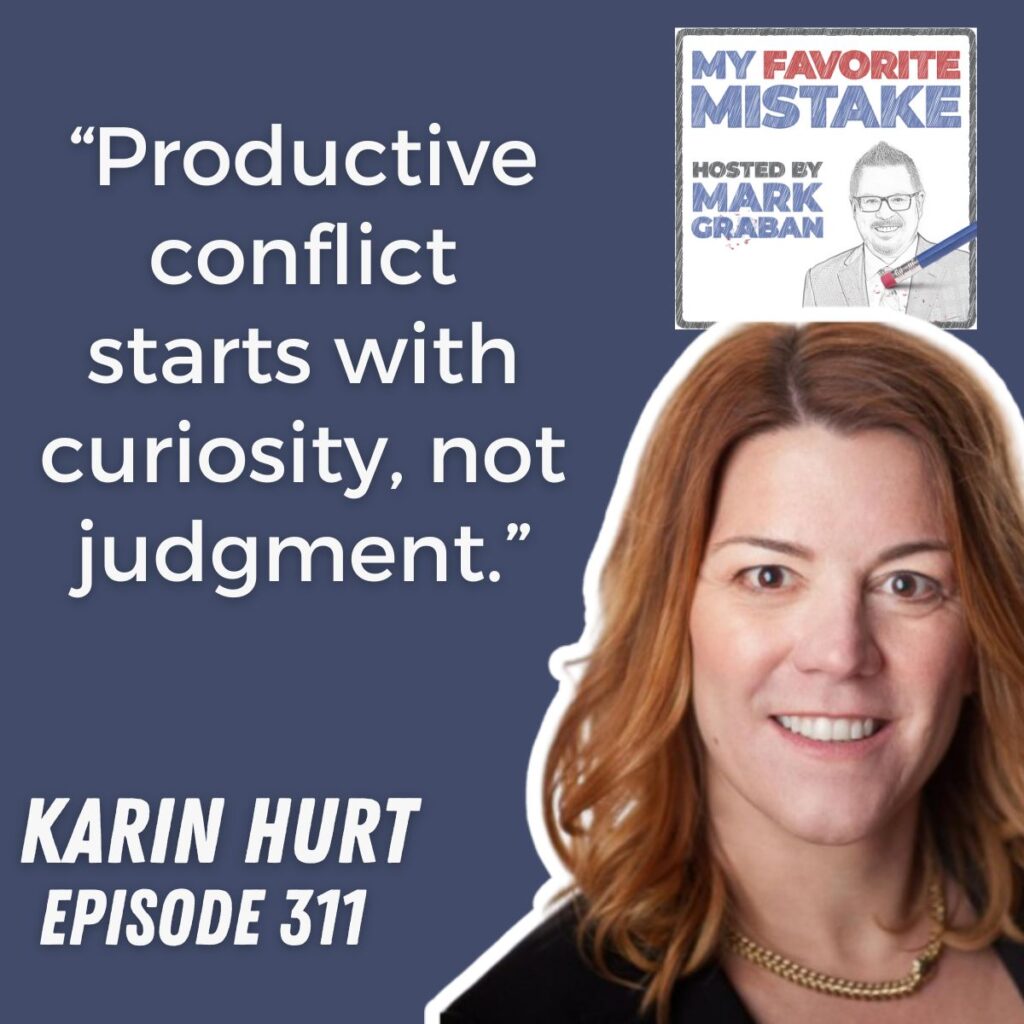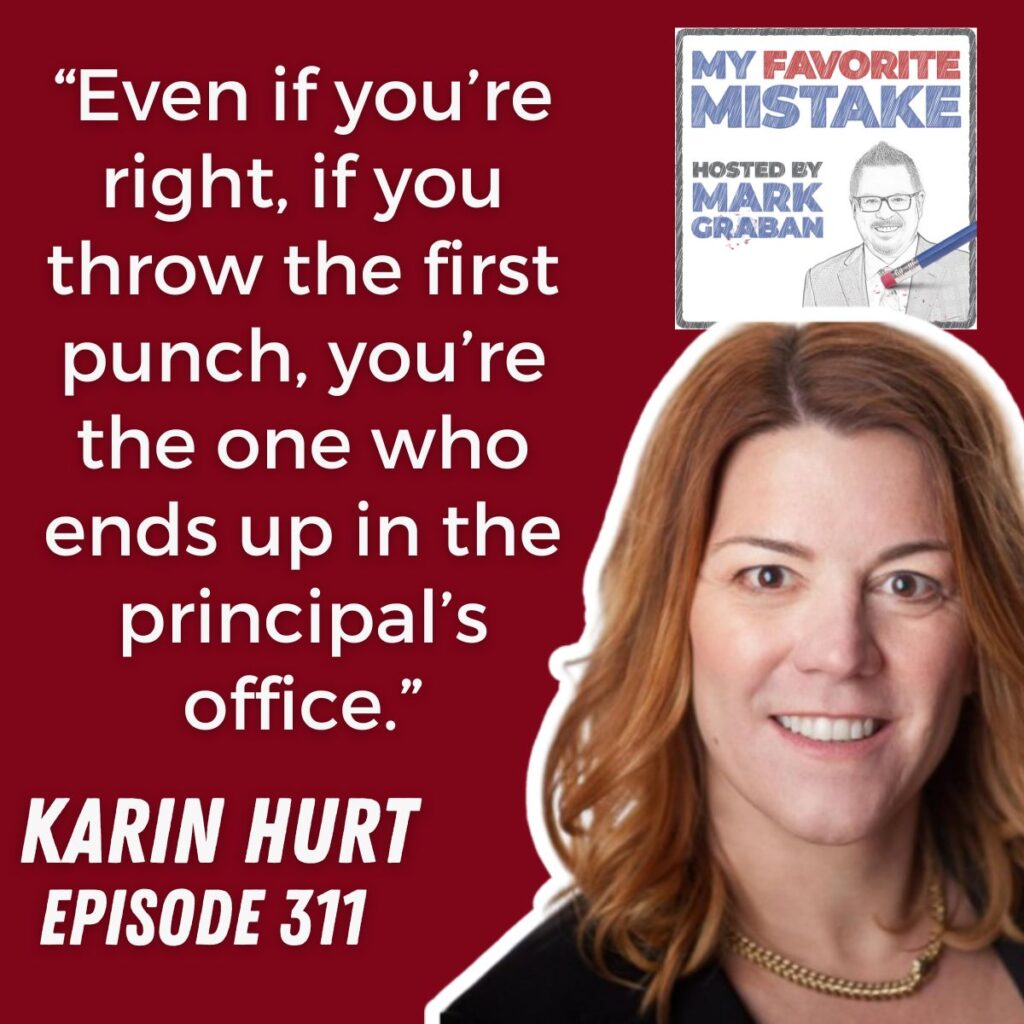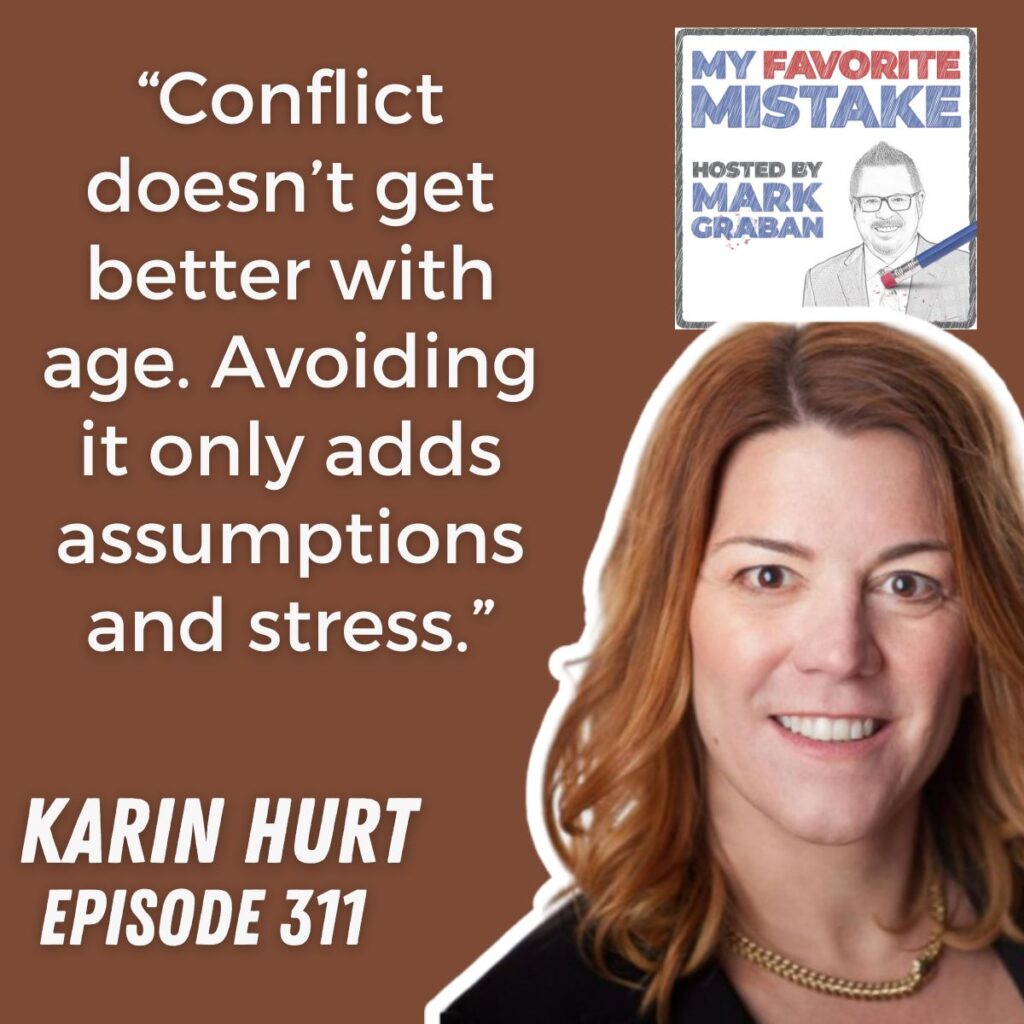Listen:
Check out all episodes on the My Favorite Mistake main page.
My guest for Episode #311 of the My Favorite Mistake podcast is Karin Hurt, CEO of Let’s Grow Leaders, a global leadership development firm. Karin is a former Verizon Wireless executive and the award-winning author of five books, including her latest, Powerful Phrases for Dealing with Workplace Conflict.
In this episode, she shares a deeply personal and professionally pivotal story from her corporate days—an impassioned confrontation over a discriminatory hiring decision that, while well-intentioned, caused serious damage to her career.
Karin unpacks how her emotional reaction—rooted in a strong sense of justice—ultimately undermined her goal. Despite advocating successfully for her team member, her public and heated delivery hurt her leadership reputation. She reflects on the importance of staying calm under pressure, choosing the right time and place to speak up, and communicating with both courage and strategy. These lessons became the foundation for the work she does today, helping leaders navigate difficult conversations with confidence and compassion.
Throughout the episode, we also discuss her transition from corporate executive to keynote speaker, author, and entrepreneur. Karin explains how she and her co-author (and husband), David Dye, help teams build cultures of “productive conflict,” where differences lead to innovation rather than division. From real-world mistakes to powerful communication tools, this episode is full of insight for leaders who want to lead with heart—and get results.
Questions and Topics:
- What’s your favorite mistake, and what did you learn from it?
- Do you think the hiring manager eventually saw the light, or was the outcome driven by HR?
- Did that incident influence your decision to leave the corporate world and start your own company?
- How did your background in HR and operations shape your leadership approach?
- When did you realize you had something valuable to share publicly through your blog?
- How did your speaking career take off, and what was the turning point?
- How do you stay calm in conflict now, compared to earlier in your career?
- What are the four dimensions of productive conflict?
- How often do leaders get in trouble for what they say versus staying silent?
- How do you advise someone to say “no” to their boss without hurting their reputation?
- What are the dynamics of working with your husband as a business partner?
- How can teams embrace conflict as a source of innovation, not dysfunction?
- What’s the danger of trying to fix systemic conflict at the interpersonal level?
- How do you handle conflict on hybrid or global teams where trust is harder to build?
- Is it easier to de-escalate conflict in person versus virtual or text-based communication?
- How do you balance encouraging courage with creating psychological safety?
Scroll down to find:
- Video version of the episode
- How to subscribe
- Quotes
- Full transcript
Find Karin on social media:
Video of the Episode:
Quotes:
Click on an image for a larger view





Subscribe, Follow, Support, Rate, and Review!
Please follow, rate, and review via Apple Podcasts, Podchaser, or your favorite app — that helps others find this content, and you'll be sure to get future episodes as they are released weekly. You can also financially support the show through Spotify.
Don't miss an episode! You can sign up to receive new episodes via email.
This podcast is part of the Lean Communicators network.

Other Ways to Subscribe or Follow — Apps & Email
Automated Transcript (May Contain Mistakes)
Mark Graban:
Hi, welcome to My Favorite Mistake. I'm your host, Mark Graban. Our guest today is Karin Hurt. She helps human-centered leaders find clarity in uncertainty, drive innovation, and achieve breakthrough results. She’s the founder and CEO of Let’s Grow Leaders, a global leadership development firm known for practical tools and techniques for human-centered leaders.
Karin Hurt:
Absolutely, my pleasure. I'm really looking forward to our conversation.
Mark Graban:
Thank you. Yeah, I'm excited that you're here. Hopefully you didn’t feel like you had to be too courageous to come talk about mistakes.
Karin Hurt:
You know, being able to talk about your mistakes is one of the most important things. To reflect on them, to share them so others don’t make the same ones. So I’m a big fan of your approach, Mark.
Mark Graban:
Okay, well, you're in the right place, so let’s get right to it. Whether from your corporate days or your company now—what’s your favorite mistake?
Karin Hurt:
It’s hard to choose just one! But since we just released our new book, I’ll talk about a mistake that relates to workplace conflict.
This was back in my Verizon days. I was leading a sales team. There was a team member—a Black man—who was highly qualified and had applied for a role in another department. The hiring executive told me he “didn’t have the look”—that set off every alarm bell I had.
Mark Graban:
Yeah.
Karin Hurt:
I was right to advocate for him. I was right to be mad. But I handled it completely wrong. I confronted the executive—after hours, a glass of wine in, with people around—and I shouted at him. I used some strong language.
Mark Graban:
People were around?
Karin Hurt:
About ten people. And guess who got in trouble? Me. HR said I’d created a hostile work environment. One of my direct reports later told me, “Even if you’re right, if you throw the first punch, you’re the one who ends up in the principal’s office.”
Karin Hurt:
That moment really stuck with me. I realized: It doesn’t matter if you’re right—if you can’t communicate effectively, you won’t get what you need. I should’ve calmed down, pulled him aside, and had a one-on-one conversation instead of calling him out in front of a group. It was a big mistake, and while the employee did end up getting the job, it came at a cost to me. My reputation took a real hit. I’ve spent my whole career trying to be a human-centered leader, and there I was, shouting and dropping an F-bomb. In fact, there’s a chapter in our new book about what to do when someone is shouting F-bombs.
Mark Graban:
Well, I appreciate you telling the story. I mean, when you talk about being human—the emotions and the righteous anger behind what you did—it’s a very natural reaction. But looking back, was it the frustration of already trying calmer approaches that didn’t work?
Karin Hurt:
Exactly. I had approached him before and laid out the case: “This guy is at 250% of quota, and he’s selling the very thing you specialize in. Why wouldn’t you hire him?” And the response felt so discriminatory. There was no logic. I was angry, and instead of taking a breath, I exploded. What I should have done was lead with curiosity: “What’s going on? Why are you making this decision?” That would have opened a more productive conversation.
Mark Graban:
So even though you got the outcome—he got the job—the collateral damage was your own brand and reputation as a leader?
Karin Hurt:
Exactly. I got the outcome, but I didn’t get my whole outcome. Because for me, the outcome isn’t just the result—it’s also about how I show up. And in this case, I didn’t show up the way I wanted to.
Mark Graban:
Was that part of what led to you leaving corporate and starting your own business?
Karin Hurt:
That came later, but it was one of many inflection points. At the time, I was in HR, with a background in organizational development and communication. One of the senior VPs at Verizon said to me, “What’s next for you?” I said, “Probably VP of HR.” And he said, “Yeah, but I’ll have more respect for you if you’ve led a large team first. Get out of HR, go lead some big operations.” That advice changed my trajectory.
So I did. I led mega call centers, big sales teams—thousands of people. And my final operations job was transforming our strategic partnership channel: 10,000 people in outsourced call centers, all struggling to ramp up after Verizon started selling the iPhone. It was chaos. And instead of shutting them all down, we worked with them to build strong cultures, coach effectively, and improve performance.
Mark Graban:
So this was like your field lab for what would become Let’s Grow Leaders?
Karin Hurt:
Exactly! I found myself telling the same stories over and over again—how to give feedback, how to run a huddle—so I started a blog to share practical tools for human-centered leadership. I never mentioned Verizon or any companies by name. I just wanted to help people. The blog exploded—international readers, best-of lists—and then I got invited to speak.
One call center VP said, “Come keynote our customer service conference.” I told him, “I’m not a keynote speaker.” He said, “Just come tell the story.” So I did. And the speaker after me was Shep Hyken, who’s a huge name in the customer experience world. He came up to me and said, “When are you leaving Verizon to do this full time?” He handed me his card and told me to call him if I ever wanted to write a book or become a keynote speaker. That was the nudge I needed.
Karin Hurt:
So I went home, thought about it over the weekend, and decided to give it a try. I called Shep. He told me to join the National Speakers Association. One thing led to another, and a year later, I officially launched Let’s Grow Leaders. Since then, we’ve worked all over the world, helping leaders develop practical, human-centered skills.
Mark Graban:
That’s a great journey. And it’s interesting how the original mistake didn’t directly spark your transition, but it was definitely part of the story. Let’s talk about your newest book, Powerful Phrases for Dealing with Workplace Conflict. I’m curious—how has your personal story informed the tools you now teach?
Karin Hurt:
All the time. The higher the stakes, the more conflict you’re going to face. So in our programs and in the book, we teach a framework for handling conflict productively. It starts with asking: What’s really going on here?
We break it into four dimensions:
- Connection – Are we connected as human beings?
- Clarity – Do we have a shared understanding of success?
- Curiosity – Are we genuinely interested in each other’s perspectives?
- Commitment – Do we have alignment on next steps?
In the Verizon story, there was no trust between me and the other executive. I didn’t start with connection. I didn’t come in curious. I came in mad, with assumptions. That’s the opposite of how I’d approach it now.
Mark Graban:
Yeah, like Ted Lasso says—“Be curious, not judgmental.” That really resonates. And it’s something I’ve tried to improve at too: recognizing when I’m amped up, and redirecting that energy in a more constructive way.
Karin Hurt:
Exactly. And tone matters. Facial expressions matter. You might say the perfect words, but if your tone or body language sends a different message, that’s what people respond to. With video calls, we all have recordings—go back and watch yourself. What does your face say, even when your mouth is quiet?
Mark Graban:
Right. Same words, totally different meanings depending on delivery. Like: “What’s wrong with you?” can be accusatory or compassionate, depending on how it’s said.
Karin Hurt:
That’s why we wrote the book. People need actual phrases, but also coaching on how to say them in ways that reduce stress and build connection. We did a global survey of 5,000 people in 46 countries. We asked them to reflect on a past workplace conflict and what advice they’d give their former self.
- 55% said: “Stay calm.”
- 21% said: “Talk about it—or talk about it sooner.”
So many people avoid conflict altogether, but it doesn’t get better with age. When you stay silent, your mind fills in the gaps with assumptions—and those are often wrong.
Mark Graban:
Yeah, saying nothing pretty much guarantees you won’t get what you want. Saying something gives you a chance—and saying it the right way increases that chance. One section I found really helpful was about saying “no” to your boss. What’s your advice there?
Karin Hurt:
That’s a popular topic! So here’s the thing: Every time you say “yes” to something, you’re saying “no” to something else. You say yes to working late? You might be saying no to your kid’s ball game. That’s a tradeoff.
We teach leaders to say no by first saying a strategic yes. Acknowledge the importance of the project. Say, “Yes, I see how this is valuable,” then explain what’s at stake if you don’t stay focused on current priorities. Offer an alternative if possible—maybe delegate to someone else who could benefit from the opportunity. It’s not about rejection. It’s about protecting capacity and being intentional.
Karin Hurt:
And that’s especially important if the person you're saying “no” to is an idea person. My husband and business partner, David Dye, is the opposite of me. I come up with 20 ideas a day—he makes sure we actually finish the ones we commit to. We’re in constant conflict, in the best way.
He’s learned that instead of just saying, “No, we can’t do that,” he’ll say, “Interesting idea. In order to do that, we’d have to stop doing these other five things. Are you sure that’s the right tradeoff?” And usually I say, “You’re right.” That makes it a productive conversation instead of a shutdown.
Mark Graban:
Yeah, I can imagine people hearing “we’re in constant conflict” and thinking that sounds like a problem. But you describe it as productive—like constructive confrontation.
Karin Hurt:
Exactly. Conflict isn’t inherently bad. It’s where innovation comes from. If David just said “yes” to everything I came up with, our programs wouldn’t be as strong. That tension helps us do better work. Same goes for any team—you’ll always have tension between roles. What matters is whether your systems support constructive conflict.
I interviewed Ralph Kilmann, who co-developed the Thomas-Kilmann Conflict Mode Instrument. I asked if I could call him the grandfather of conflict research—he said yes! One thing he told me that stuck is this: “You can’t solve systemic conflict at the interpersonal level.” And we try to. We pit people against each other, stack rank them, and then wonder why they don’t collaborate. That’s a systemic issue.
Mark Graban:
Absolutely. It’s a mistake to blame individuals for problems rooted in system design. That comes up a lot with culture and communication breakdowns.
Karin Hurt:
Yes—and hybrid and global teams have even more complexity. One client told me there’s only one hour a week when their whole team can meet across time zones, and even then it’s 9 p.m. in India. That makes it harder to build trust. You don’t know people well, so you don’t know whether to trust them. And you’ve got matrix structures where people are accountable for things they can’t always control. That’s a recipe for conflict.
Mark Graban:
And then leaders just say, “Work it out.” That doesn’t fix the underlying issues.
Karin Hurt:
Right. And then we’re having these complex conversations through Slack or email or Teams, where tone is lost. That’s why we say: the more emotionally complex the conversation, the wider the communication channel you need. “Can you get that report in by Friday?”—fine for Slack. But if you’re putting someone on a performance plan, you better do that in person, or at least over video.
Mark Graban:
Yeah, there’s a reason people get so upset about being laid off by text message or Slack. It sends a message—just not the one leaders think.
Karin Hurt:
Exactly. The channel is the message. Marshall McLuhan said that in the 1960s, and it’s even more true now. You have to use the right medium for the message, especially when emotions are involved.
Mark Graban:
You also mentioned Brene Brown earlier—she says, “It’s hard to hate people up close.” That human connection really matters. So as a final topic: how do you balance encouraging people to be courageous with creating environments that are psychologically safe?
Karin Hurt:
Great question. Amy Edmondson, who pioneered the concept of psychological safety, actually wrote the foreword to our book Courageous Cultures. She says courage and psychological safety are two sides of the same coin—both are necessary in a complex world.
Courageous Cultures was written for executives: how to build an environment where people feel safe to share ideas. But we realized that wasn’t enough. You also need to teach people at every level how to speak up in ways that will be heard. That’s why we created Powerful Phrases—to help people be more daring and more effective.
Mark Graban:
That’s a great combination of tools. And yes, Amy Edmondson was a guest on this podcast too. It’s amazing how those threads connect.
Karin Hurt:
She’s wonderful. I’m so glad we got to work with her. And thank you, Mark, for having me. This was a fun and meaningful conversation. I look forward to having you on Asking for a Friend soon!
Mark Graban:
Thanks, Karin—and thank you again for sharing your story and your insights.
Episode Summary and More
3 Actionable Takeaways from the Episode
Balance Psychological Safety with Encouragement in Leadership
Karin discussed the dual importance of creating a psychologically safe workplace while encouraging courage. Dr. Amy Edmondson, mentioned by Hurt, asserts that “psychological safety and courage are two sides of a very important coin.” Listeners can strive to cultivate an environment where team members feel secure to share ideas and take risks, while also training them in how to communicate their inputs effectively.
Embrace Courageous Conversations
Karin Hurt shared an incident from her corporate days where she aggressively advocated for a qualified team member who was facing discrimination. Instead of defaulting to conflict, listeners can be inspired to address critical issues head-on, ensuring conversations are constructive and held in a private or appropriate setting to reduce reputational damage. As Hurt reflected, “What I should have done is taken a beat, calmed down, pulled him aside… without an audience.”
Develop a System for Effective Feedback
The episode emphasized the importance of using powerful phrases and strategies in dealing with workplace conflicts. Listeners can implement feedback systems that incorporate the dimensions of productive conflict: Connection, Clarity, Curiosity, and Commitment. Hurt noted, “When you are in a conflict, pause and say, what is going on here?” Structuring feedback with these elements can turn potentially negative conflicts into productive discussions.

